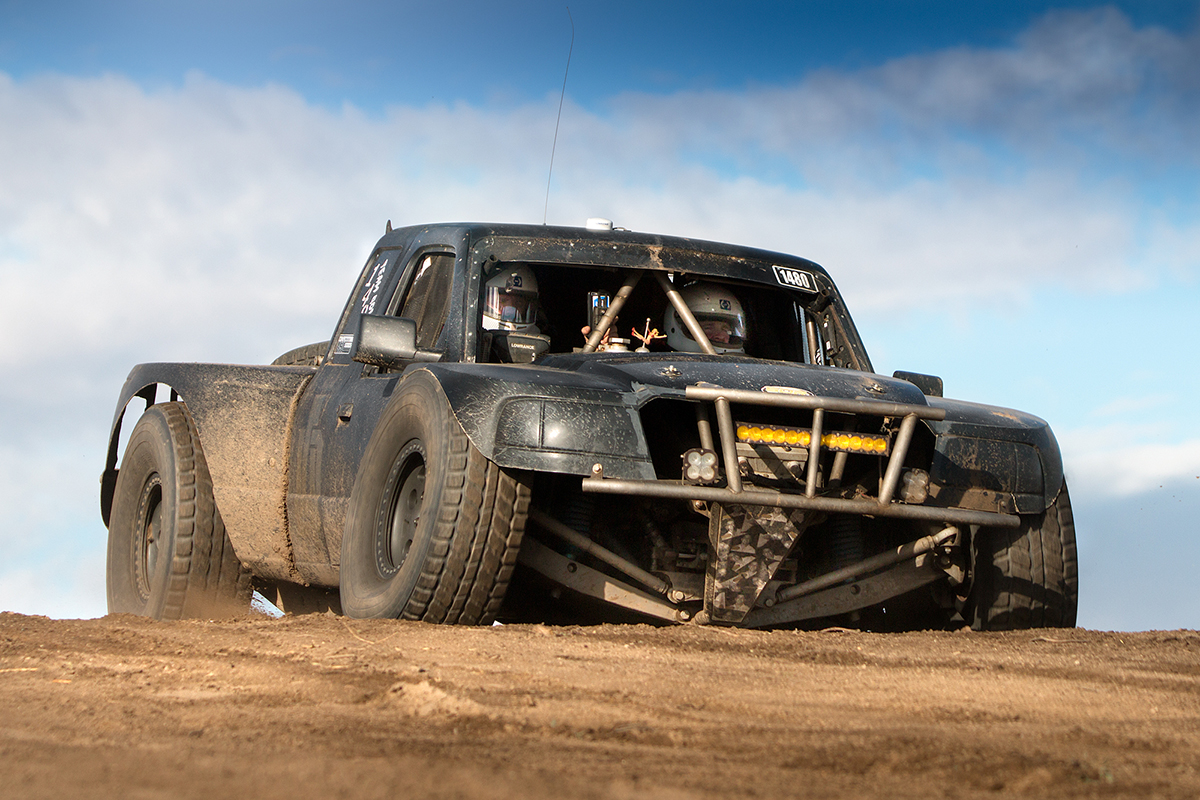Race to the Photo Finish
Dan Schenkelberg revs up his camera to photograph motorsports with the Tamron SP 150-600mm VC G2 lens.
By Jenn Gidman
Images by Daniel Schenkelberg
When Daniel Schenkelberg was a teenager growing up in California, his first camera came from an unlikely source: the crime-scene department at the San Diego Police Department. His dad was a city police officer for nearly 30 years, and he handed his work camera over to Daniel when his son was still in high school. "I should've known back then that photography was my calling, but I didn't see it yet," Daniel says.
He played around taking pictures in between doing other "normal-kid" stuff like skateboarding and BMXing, but he passed up going to the Brooks Institute of Photography when he got older and worked odd jobs instead, indulging his other passion, drag-racing, on the side. But he eventually found his way back to photography—first editing for a portraiture company, then taking pictures for a car dealership, and finally deciding to make a break from the nine-to-five world about 18 months ago to merge his two loves: photography and motorsports.
"I try to set my work apart by finding the passion behind it and capturing moments no one else does," Daniel says. "I studied fine art a lot growing up, and that plays into my editing style—whether it's impressionism, photojournalism, or even music, it all intertwines with the racing and has allowed me to create a style that's all my own."

The fast pace of the sport is also a major appeal. "I love getting out there to do this kind of adrenaline-charged photography," Daniel says. "The setting changes every single time, even if you're at the same site. And you can't replicate these photos in a studio, even if you tried. That keeps every shoot fun and exciting."
The lens that helps Daniel tell the motorsports stories he wants to convey: the Tamron SP 150-600mm VC G2. "The focal length range on this lens is terrific, and it's super-sharp," he explains. "And even though the lens is big, it isn't so heavy that I can't carry it all day—and I have long days. This lens is my favorite."
Before he heads out to the race site, Daniel makes sure he has plenty of snacks and water, backup batteries and memory cards, and a reflective vest. To keep his 150-600 lens safe, Daniel tapes it up tight. "When I'm shooting, there's often dirt and sand flying at me, which can be as fine as baby powder," he says. "I tape up every little crevice on my lens, because I can't take the chance of anything getting in there.
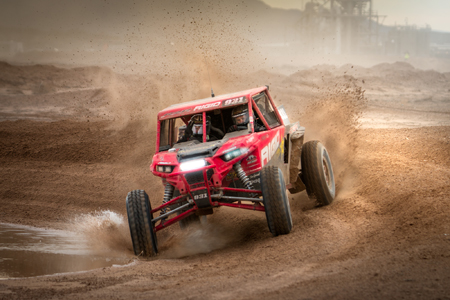
The lens does its part to keep Daniel safe, too. "Shooting this sport is really dangerous," he says. "I've had trucks roll right in front of me, parts break off—you have to be ready for anything whenever a vehicle rides by. The focal length of 150-600 helps keep me at a safe distance, but it still turns out really sharp images—and I still feel like I'm close even when I'm actually far away in the safe zone."
On the Track
Where a photographer stands depends on the race. "You could be looking through a photo hole with a bunch of other photographers at a traditional track," Daniel explains. "Or, if you're out at a desert race, it could be a little crazier. For those types of races, no one really knows what the race course will be until about a week beforehand. Then they release a GPS file, which I either put into Google Earth or into my navigation system so I can find the site."
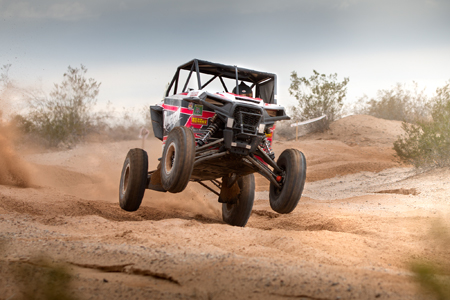
At that point, Daniel will either drive directly to the location or start doing research, usually checking out photos or YouTube videos from the same site (or similar ones) online. "You can't photograph this type of race without doing your homework," he says. "If I can find photos of the actual racetrack, I'll start marking it up with little x's, based on where I think the best places to position myself will be on the day of the race."
That research comes in particularly handy when it comes to taking the sun into account, Daniel notes. "If you haven't done your homework, you could be at one spot hoping for good light, and the light could be terrible," he says. "You want to know where the sun is rising and setting, for example. I also like playing with highlights and shadows, and always want to make sure the exposure is pretty spot-on, so I check out locations beforehand to study where the light is best so I can capture it the way I want to."
Because he grew up shooting film, Daniel always shoots manual so he can control the light and everything else he's doing. "For focusing purposes, I'll usually shoot in AI Servo mode," he says. "Sometimes the autofocus is fast enough, but if a car is coming over a hill at me, it won't be. What I'll do is manually focus beforehand, set it, and tape down the ring. That way, when the car finally peeks over the top, I can snap the photo real quick. I'll use a remote trigger sometimes, too."
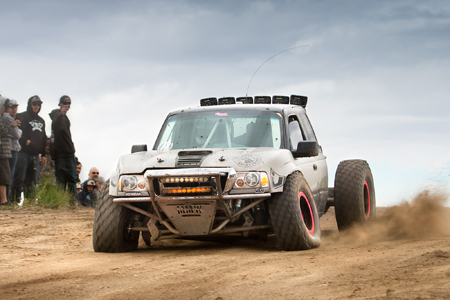
Daniel typically shoots in burst mode for the action shots, often panning along with his moving subjects. "It depends how far away from me the car is and how fast it is, but I'll shoot at anywhere from 1/80th of a second to 1/30th of a second, with my ISO during the day usually set to 100," he says. "And I usually shoot wide open, except when there's two cars in the photo—in that case, I'll stop down a lot to get the other car in focus."
When he's shooting his high-octane imagery, Daniel often treats his automotive subjects like portrait models. " When I want to show the scenery or the setting, I'll compose the photo using the basic rule of thirds," he says. "I'll shoot wide and get the smoke trail and the background in to establish a sense of place. But I also like to capture close-ups of the cars, especially when they're up in the air or landing."
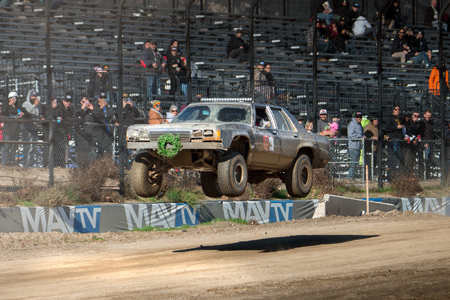
In addition to capturing those action shots, Daniel tries to show the human element in his photos. "During the desert races especially, when the drivers see photographers standing on the edge of a corner as they're shooting up all the rocks and dust, the co-driver will throw out a peace sign or thumbs-up if I'm lucky," he explains. "It's cool to see what the car is doing, but it's also cool to see the guys inside enjoying it."
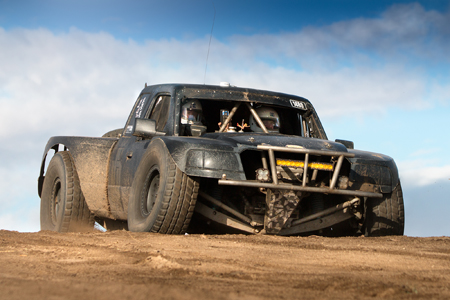
"The people are really what drive the sport," he continues. "I like to show what goes on behind the scenes and what it takes to make a race. I can sometimes be with these teams till 2 or 3 in the morning, then wake up at 5 to head to the track. Showing the dedication and commitment these people have for the sport is what tells the real story."
When he's done at the race and back behind the computer, Daniel tries to make each photo his own without going too over the top. "People think I use crazy filters, but it's really just basic curves adjustments, dodging and burning," he says. "I'm kind of a purist, even though I edit. I like shooting the story, capturing that particular moment, and then putting my artistic twist on it in post-processing, but without going overboard to the point where nobody buys it."
What elevates motorsports photography for Daniel is its ability to incorporate other types of photography into the mix. "It's really fun to work on your toes and to bring other genres into your work," he explains. "I love seeing different styles worked in—whether it's portrait, photojournalism, documentary, even landscape photography—rather than mundane point-and-shoot, 'this is what the car did' kind of stuff."

For photographers determined to enter the motorsports scene, Daniel says the best way to gain access is to simply ask the race promoters. "That's what I did when I shot my first event in 2009," he says. "You'll sometimes find other helpful photographers at the race who can give you tips when you're starting out. The important thing is to meet new people who know the sport and forge relationships."
A final piece advice: "You have to have a passion for it," Daniel says. "That passion, not a paycheck, is going to push you through the long days out there in the dust when you're subsisting on almonds for lunch and dinner."
To see more of Daniel Schenkelberg's work, go to www.danielschenkelberg.com.
